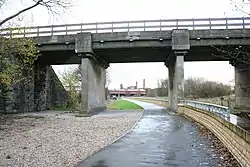Adam Viaduct | |
|---|---|
 A view of the viaduct before the construction of the Southgate road. | |
| Coordinates | 53°32′28″N 2°38′52″W / 53.54098°N 2.64765°W |
| Carries | Kirkby branch line |
| Crosses | River Douglas, A49 Southgate link |
| Heritage status | Grade II listed building |
| Characteristics | |
| Material | Prestressed concrete |
| Total length | 120 feet (37 m) |
| Width | 29 feet 9 inches (9.07 m) |
| No. of spans | 4 |
| Rail characteristics | |
| Track gauge | 4 ft 8+1⁄2 in (1,435 mm) standard gauge |
| History | |
| Designer | William Kelly Wallace |
| Engineering design by | London, Midland & Scottish |
| Constructed by | Leonard Fairclough Ltd |
| Construction end | May 1946 |
| Replaces | 1847 timber bridge of the same name |
| Location | |
The Adam Viaduct is a grade II listed concrete underbridge in Wallgate, Wigan. The bridge, constructed in 1946, is the earliest prestressed concrete railway bridge in the United Kingdom, with only some examples in Switzerland being earlier.[1][2] It is bridge number 54 on the Kirkby branch line and is at a line distance of 18 miles 1,032 yards (29.91 km).[3]
History and construction

The bridge was constructed as a test case, to see if prestressed concrete construction was feasible for rail projects in the UK, by the LMS railway company, and designed by their chief civil engineer William Kelly Wallace.[4][5] The beams used were prestressed using the Freyssinet system, in which concrete is precast with stressed high-tensile-strength metal tendons, which consist of multiple steel wires, running down the length of them. In construction, the beams internal rods are tightened and tied together so, under live load, they act as one. The LMS developed this system in the 1930s, and prestressed beams were first used for emergency repairs during World War II, but the Adam Viaduct first to use them for a full-scale project.[1] The benefits of the system were found to be that it was quicker to install, more economical and longer-lasting, and with the bridge being less lively than traditional designs.[4][6]
The bridge has six I-beams for each track and two beams for each parapet, and they are 2 feet 8 inches (0.81 m) deep.[5] It was erected in 1946 on the foundations of an earlier Victorian bridge, created as part of the Liverpool & Bury Railway in 1847, which was made from timber with masonry abutments.[4] The earlier bridge was strengthened three times in: 1869, 1888 and 1906.[5]
Southgate
.jpg.webp)
Southgate, a bypass of the A49 from Pottery Road and Saddle Junction, passes underneath the bridge and next to the River Douglas. The road, which officially opened in March 2013, was constructed to reduce traffic in the area.[7]
References
- 1 2 Historic England. "Adam Viaduct (1061327)". National Heritage List for England. Retrieved 17 August 2018.
- ↑ James Sutherland; R. J. M. Sutherland; Dawn Humm; Mike Chrimes (2001). Historic Concrete: Background to Appraisal. p. 254,258. ISBN 9780727728753.
- ↑ "Adam Viaduct Viaduct". The ABC Railway Guide. Retrieved 17 August 2018.
- 1 2 3 R. L. M'ilmoyle (20 September 1947). "Prestressed Concrete Bridge Beams Being Tested in England". Railway Age. Vol. 123. Simmons-Boardman Publishing Company. pp. 54–58.
- 1 2 3 Robert William Rennison (1996). Civil Engineering Heritage: Northern England. Thomas Telford. p. 239. ISBN 978-0-7277-2518-9.
- ↑ "History of Prestressed Concrete in UK". Cambridge University. 2004. Archived from the original on 25 August 2018. Retrieved 27 January 2019.
- ↑ "New road relief". Wigan Today. 27 November 2012. Archived from the original on 25 April 2019. Retrieved 17 August 2018.
External links
- Pre-stressed Concrete Railway Structures
- History of Concrete Bridges Archived 14 December 2013 at the Wayback Machine